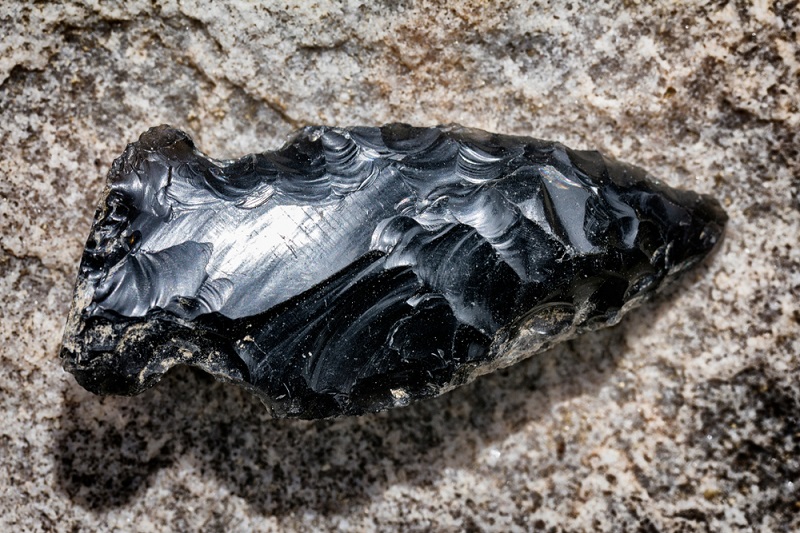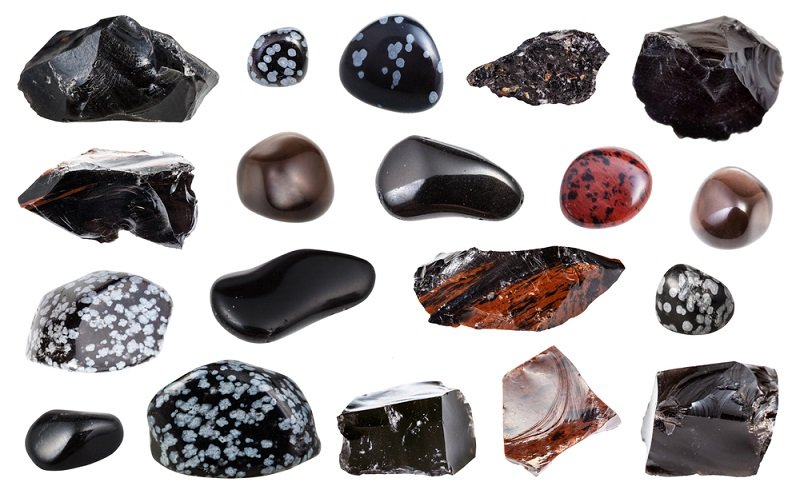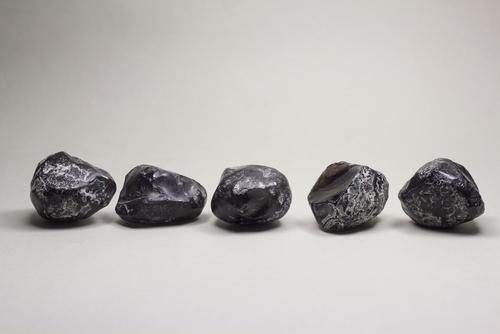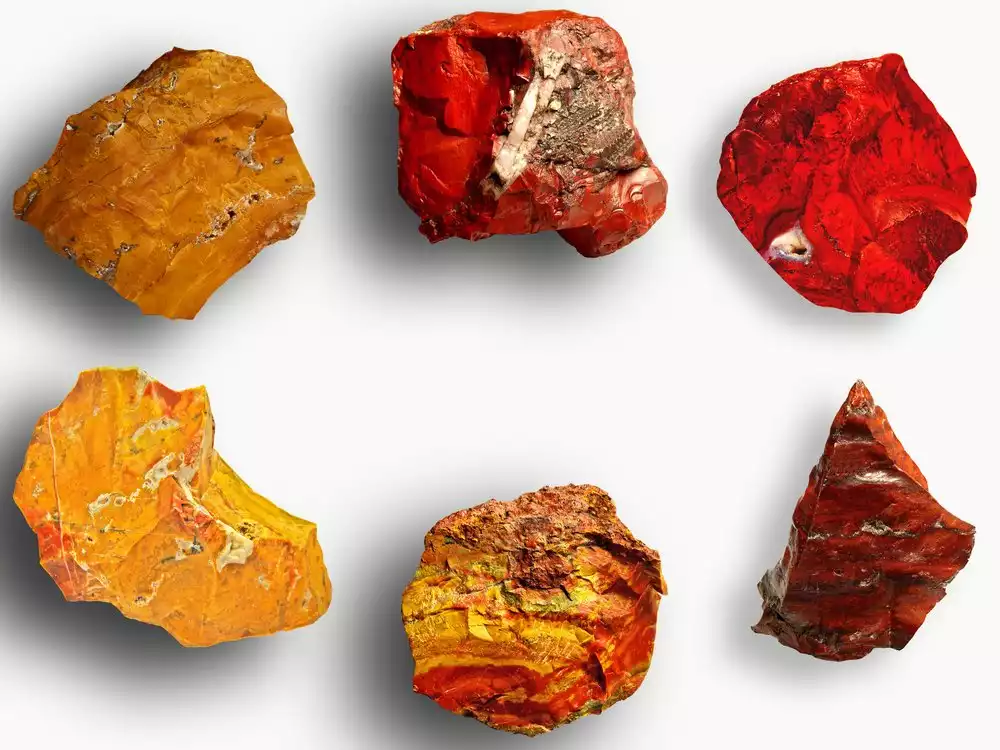Obsidian is one of the most-talked-about stones around. It’s easy to see why… few stones share the same deep black coloration and it’s been used in artifacts since the dawn of mankind. Obsidian can be found across wide parts of the United States, but it’s not well understood.
Ready to learn a bit about this shiny volcanic glass? Let’s get right to it and dig down into some interesting facts about obsidian!
1. It’s Not a Stone

Obsidian isn’t a rock or stone. It’s a glass.
Obsidian is actually an amorphic solid, despite the fact that it appears to be a stone at a casual glance. The difference here is simple: obsidian lacks an internal crystalline structure.
Indeed, the fact that obsidian is glass instead of a crystalline mineral is responsible for many of the unique properties that humans take advantage of. The actual makeup is very similar to rhyolite, with an extremely high silica content laced with impurities.
It’s also not really possible to call it a mineral as the individual makeup of various obsidian flows are too different from each other. Minerals are usually a known chemical compound crystallized into whatever form, sometimes with impurities either in the crystalline matrix (as seen in amethyst) or just present throughout the structure (for material like chrome chalcedony).
While it may seem a small thing, since it still looks, feels, and carves like a stone, it’s actually an important distinction that puts obsidian’s shiny black surface into a different context.
2. Obsidian Was an Ancient Trade Good

Obsidians use in artifacts dates back to the dawn of humanity. While flint is the material known best to many people, obsidian is a superior material for tools in almost every way. It’s also more highly regarded for ornamentation.
The cool thing is that it works just like every other knappable stone (ie: flint, jasper, chert)… but better. The conchoidal fracture travels more smoothly than in stones with a crystalline grain structure, no matter how fine.
Because of this, obsidian was transported across large areas as an important trade good. It doesn’t occur everywhere, so groups that lived near large deposits could bring it to trade for other goods during their travels.
In North America, the subject has been studied extensively. The studies were prompted by discoveries of obsidian artifacts in regions known to not hold obsidian. The Mayan and Aztec empires also used it extensively.
While not the only trade good from early in human history, the use of obsidian in tools undoubtedly made it one of the most important!
3. Obsidian Can Hold a Monomolecular Edge

Monomolecular edges aren’t just a hallmark of cyberpunk stories. Obsidian can be knapped to an edge so fine that air will dull it over time, a true monomolecular edge is possible if the flakes are placed properly.
This has lent use to obsidian well into modern times. One of the most “common” uses is in obsidian scalpels. While these are often pushed as a superior alternative to steel, they do have some problems and aren’t replacing steel anytime soon. Regular scalpels hold an edge better, and extra sharpness isn’t required in most surgeries.
That said, they do find use in eye surgery, where small and ultra-clean cuts are a priority.
This edge is also why obsidian has been used since the dawn of our species for weapons. Many people are surprised to find out, for instance, that an obsidian arrowhead is often sharp enough to penetrate entirely through a deer’s rib cage and pass through the other side.
4. There Are Many Varieties of Obsidian

While most of us think of obsidian as a black stone, the massive differences in impurities actually create dozens of varieties of obsidian to choose from.
Among the more common are Snowflake Obsidian, Golden/Silver Sheen Obsidian, and Mahogany Obsidian. All of these are commonly available, although costs vary, and there are rarer forms like Fire Obsidian that have emerged as well.
It’s a truly dazzling display of diversity. Who knew volcanic glass could be so varied?
Unfortunately, obsidian is a glass and that also means plenty of unscrupulous dealers will sell slag glass, or even outright fabricated fakes, to the unwary. The most common fake, in my experience, is “green obsidian” which is usually just green-colored glass. Red is also another common fake. These varieties do exist, but even finding a picture of one is hard… let alone finding it for pennies per gram on eBay and Etsy.
I’ll give you a hint: if the obsidian variety you’re looking at is called [color] obsidian and it’s largely transparent… it’s a fake.
But as long as you can sort the good from the bad, obsidian has many, many variations to choose from without needing to get into “exotic” fakes.
5. Obsidian Emerges in a Variety of Forms

Obsidian’s volcanic birth lends it to appear in many forms. These forms are often collectible in their own right, making some localities hotspots of valuable obsidian when compared to others.
The majority of obsidian that emerges is in nodules. These can range from a few inches across to large boulders depending on where you’re hunting, and they often resemble agate or jasper nodules in shape. In other words: a bit irregular and rounded.
In Hawaii, on the other hand, it’s possible to find both long fibers and fibers with a rounded drop on one end. The latter nodules are commonly referred to as Pele’s Tears in a nod to the island’s volcanic goddess.
Apache tears, on the other hand, are small, round nodules found in the continental USA.
My personal favorite form of obsidian is the needles that emerge very rarely, but are mainly found in the Davis Creek area of California. These elongated needles occur in black, mahogany, and the occasional rainbow obsidian variations.
If you’re hunting for obsidian, then the location you journey to is going to largely determine what you’re going to find. Why not take a look at our guide to places with obsidian in the US!
- Online rock and mineral club for collectors of all levels!
- Find community with like-minded rock and mineral enthusiasts.
- Monthly Giveaways!
- Free Access to Entire Digital Library of Products (current and future products)*


